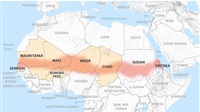'Unprecedented' Australian bushfires directly affected one in eight Indigenous people

One in eight Aboriginal and Torres Strait Islander
people in Australia were directly impacted by the 2019-20 bushfires, the
bushfire royal commission has heard.
And according to a study of the geological records
of large fires in Australia’s history, the summer bushfires were
“unprecedented”.
The royal commission into national natural disaster
resilience heard 15 witnesses on cultural burning on Thursday at the end of three
days of hearings focused on hazard reduction.
Bhiamie Eckford-Williamson, an Euahlayi man and
academic from the Australian National University, told the royal commission
that 96,000 Aboriginal and Torres Strait Islander people, including 35,000
children, were affected by the fires that burned in Queensland, New South
Wales, the Australian Capital Territory and South Australia this summer.
That amounts to 29% of the Indigenous population in
affected states, and 12% of the national Indigenous population.
And the Indigenous population in areas hit by
bushfires was 4.6%, double the population in the state as a whole, meaning that
Indigenous people were “disproportionately affected”.
Despite this, he said, there had been an
“extraordinary absence of Aboriginal people” from post-fire inquiries, and a
lack of recommendations or policies specifically geared to acknowledging or
reducing the impact on Aboriginal people.
Eckford-Williamson gave evidence in a panel
alongside the University of Wollongong researcher Vanessa Cavanagh, a
Bundjalung and Wonnarua woman and former firefighter researching the role of
women in cultural burning; associate professor Michael-Shawn Fletcher, a
Wiradjuri man and paleo-ecologist from the University of Melbourne; and Dr
Timothy Neale from Deakin University.
Eckford-Williamson said that the cool-burn
techniques used by Aboriginal people could not be appropriated into western
fire management processes, or divorced from the context of other Indigenous
land management practices.
“Simply put, if Aboriginal people are not in control
of the preparation [and] implementation of burning then it is not cultural
burning,” he said.
That is what happens in the NSW national parks and
wildlife service, which told the commission that while Aboriginal people
undertook low-intensity cultural burning, it also had parks staff who undertook
“culturally-informed burning”.
Fletcher said a study of the geological record
showed no records of a fire event equivalent to the 2019-20 season, with fires
stretching from Queensland to Victoria.
“In that sense these fires are unprecedented in the
geological record,” he said.
He said that records from colonial settlers in
Victoria showed a “universal shift from an open to a woody or forested
landscape following the British invasion and the removal of cultural burning
from the landscape”.
He added that while global heating was undoubtedly
increasing the fire risk, the landscape now had “demonstrably more fuel in the
modern forested region … today than when they were under Indigenous cultural
burning”.
All four experts said there should be a national
coordinating body that supported and conducted research on behalf of local
groups conducting Indigenous land management practices, and that funding for
that work, which currently runs on one- to three-year cycles, should be made
permanent.
Scott Falconer from the Victorian Department of
Environment, Land, Water and Planning told the inquiry that until the cultural
burns program began in 2017 there had not been any cultural burning on the
landscape for at least 150 years. Since then, 20 burns have been conducted, and
more than 100 have been identified by the six traditional owner groups involved
in burning in Australia.
NSW also did not conduct any authorised cultural
burning on public land until 2017, Queensland started supporting the practice
in 2007, and the NT has been supporting it since 1981, when the joint
management of national parks first began.







